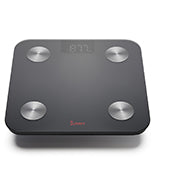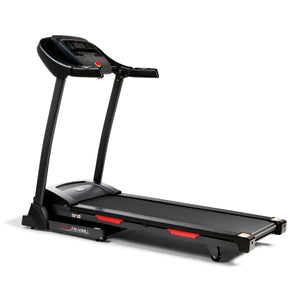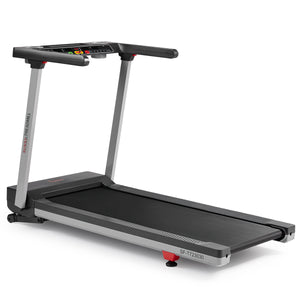Walking and running are timeless activities. Whether you're just starting your fitness journey or you're an experienced athlete, these activities are always a great fit. Just like the little black dress in fashion, walking and running never go out of style, and both provide a versatile foundation for anyone looking to stay active and healthy.
We will dive into the internal benefits of walking, running, and sprinting, and explore how these activities improve mental health. Additionally, we will discuss the benefits of both outdoor and treadmill workouts and highlight how community and competition can keep you motivated. Plus, we’ll give you a simple 5-week training plan to kickstart your routine and help you achieve your first 5k.
The Concept of "Fit from the Inside Out”
When it comes to exercise, many people tend to prioritize external visual results like toned muscles, weight loss, and a leaner physique. However, the real transformation starts inside the body at the cellular level with good mitochondrial health.[1]
Although it might take several weeks for you to notice external visual changes, the internal changes and adaptations that are happening during each workout can have a quick, profound impact on your physical, emotional, and mental well-being. In fact, studies suggest that even moderate intensity running can boost your mood and improve your executive functioning within just a few sessions.[2]
Walk Before You Run, or Just Keep Walking
The age-old saying that you should walk before you run is advice that is rooted in science and makes perfect sense for those just getting started with a new fitness plan. However, if running is not in your plans – that’s fine too.
Research suggests that walking as a stand-alone practice can positively impact your health. Walking is one of the simplest, most accessible exercises you can do. It’s low-impact, which makes it ideal for any stage of your fitness journey, whether you’re a beginner, recovering from an injury, or simply wanting a break from your high impact routine.[3]
Walking is more than just a warm-up; it’s a powerful tool for overall health. Here are 5 of our favorite internal benefits of walking:
- Improved Cardiovascular Health: Walking increases your heart rate, which helps improve circulation and strengthens the heart. Research suggests that it reduces the risk factors for cardiovascular disease.[4]
- Boosts Mental Clarity: Regular walking can reduce stress, boost mood, and improve mental clarity, thanks to the release of endorphins.
- Weight Management: Although walking is less intense than running, it can still help with weight management by burning calories and increasing metabolism.
- Strengthens Muscles and Bones: Walking engages muscles in the legs, hips, and core, improving muscle tone and bone density over time.
- Improved Blood Sugar Levels: A daily walk can help regulate blood sugar, making it beneficial for people with diabetes or those at risk.
Stepping It Up
For those who wish to take their walking routine to the next level, stepping up the pace to a jog or run is a natural progression. Stepping up to the next gear brings its own set of unique benefits. Running is a higher-impact activity, which further challenges the cardiovascular system and enhances endurance. Here’s how running benefits your body internally:
- Enhanced Cardiovascular Health: Running increases your heart rate even more than walking, leading to stronger, more efficient heart and lung function.
- Boosts Metabolism: Running burns a significant number of calories in a short amount of time, which can aid in weight loss and overall fat burning.
- Increased Endurance: As you run regularly, your stamina and endurance improve, not just in your legs, but in your body as a whole.
- Muscle Development: Running activates muscles in the lower body (calves, quads, hamstrings, glutes), building strength and improving overall muscle tone.
- Boosts Immune System: Regular running can enhance immune function, reducing the frequency of illness and speeding up recovery. A compelling article by Neiman & Wentz (2018) shares that exercise training has an anti-inflammatory influence on the body, especially when training is done on a regular basis.[5]
The Ultimate Challenge
For those who are ready to push their limits, sprinting is the final frontier. Sprinting offers the highest intensity and the greatest rewards in terms of fitness gains. It involves short bursts of speed that challenge the body in ways walking and moderate paced running cannot. I often refer to sprinting as the ‘body building of running’ because it promotes muscular strength and power in similar ways as traditional strength training programs.[6]
But be aware, sprinting is not safe for everyone because of the intense stress it places on the body. It is not recommended for those who are new to exercise, and even those who are of an intermediate level should take great care to properly warm up and ensure your muscles and tendons are ready for the stress. There is a greater risk of injuries when you run as fast as you can; muscle tears, sprains, and strains are all frequent sprinting injuries and are particularly common if you are deconditioned.[7]
If you are ready for a sprinting challenge, here are 5 incredible benefits of speeding up your run:
- Fast-Twitch Muscle Activation: Sprinting engages fast-twitch muscle fibers that contribute to strength and speed.
- Maximum Calorie Burn: Sprinting burns more calories in less time than running due to its high intensity nature.
- Improved Anaerobic Capacity: Sprinting increases your anaerobic threshold, which helps improve performance in all high-intensity activities.
- Increased Power and Strength: Sprinting strengthens muscles and bones through repeated explosive movements.
- Fat Loss: The intense nature of sprinting leads to significant fat loss, even after the workout has ended (thanks to a phenomenon called excess post-exercise oxygen consumption, or EPOC).
Start Today
Hopefully you’re inspired and motivated to get walking or running so that you can reap the rewards of the many associated health benefits. If you’re still a little unsure of how to get started with a new walking or running program, below is a simple program to follow to get you ready to walk or run your first 5k, an achievable and fun distance for most exercisers.
5-Week to 5K Training Plan
A simple training plan is essential to help you gradually build strength and endurance. Here’s a straightforward 5-week program to get you from walking to running your first 5k.
| Week | Monday | Wednesday | Friday | Sunday |
|---|---|---|---|---|
| 1 | 20-min walk | 1-min run, 2-min walk x 6 | 20-min walk | 1-min run, 2-min walk x 6 |
| 2 | 25-min walk | 2-min run, 2-min walk x 6 | 25-min walk | 2-min run, 2-min walk x 6 |
| 3 | 30-min walk | 3-min run, 2-min walk x 6 | 30-min walk | 3-min run, 2-min walk x 6 |
| 4 | 35-min walk | 4-min run, 2-min walk x 6 | 35-min walk | 4-min run, 2-min walk x 6 |
| 5 | 40-min walk | 5-min run, 2-min walk x 6 | 40-min walk | 5-min run, 2-min walk x 6 |
In addition to walking and running, it’s a great idea to incorporate some mobility and stretching into your workout routine. Focus on moving your joints through their full range of motion and optimize your flexibility to help with performance and injury prevention. You can find many guided walking, running, and stretching workouts on the SunnyFit App.
Interestingly, research has shown that joining a fitness community and using tracking tools can really help to keep you accountable to your fitness goals. Signing up for a race, a fitness challenge, or joining a walking or running group can help keep you motivated and prevent you from skipping out on your planned training schedule.[8]
Indoor or Outdoor Workouts?
While both outdoor and treadmill workouts provide great benefits, each offers a unique set of advantages. Overall, the best approach is to train in a way that best suits your lifestyle and circumstances, with the main goal of keeping it simple and easy so you can be as consistent as possible. As you make your decision, here are a few benefits to keep in mind:
Treadmill Workouts:
- Convenience: You can work out regardless of the weather, and you can track your pace, distance, and time easily.
- Controlled Environment: Treadmills offer a steady, predictable surface, which can be easier on the joints than running outdoors on uneven terrain.
- Variety: Many treadmills allow you to adjust incline, speed, and workout programs to challenge yourself in different ways.
- Tracking: Tracking your performance and following a professional workout is often easier on a treadmill, especially if you invest in a Bluetooth-enabled or WiFi-enabled treadmill with App connectivity.
Outdoor Workouts:
- Scenic Motivation: Running or walking outdoors offers the opportunity to explore new environments, which can make the workout feel less monotonous.
- Fresh Air: Being outside provides a healthy dose of vitamin D from the sun and allows for natural exposure to the elements.
- Increased Intensity: Outdoor runs, particularly on trails or hills, provide a more varied and sometimes more challenging terrain, which can boost your fitness levels and challenge your balance and stability.
The Happiness Boost
One of the greatest benefits of walking, running, and sprinting is the positive impact on mental health. Exercise, particularly cardiovascular activities like walking and running, helps release endorphins, often referred to as “feel-good” hormones. These endorphins can:
- Reduce Stress and Anxiety: Regular physical activity helps to lower cortisol levels, the stress hormone, while boosting serotonin and dopamine, which improve mood.
- Combat Depression: Studies have shown that regular exercise can reduce symptoms of depression and anxiety by promoting brain plasticity and improving emotional regulation.
- Improve Sleep Quality: Physical activity helps you sleep better, which, in turn, enhances overall mood and energy levels.
- Increase Cognitive Function: Exercise stimulates brain activity and helps improve concentration, focus, and memory.
Whether you choose walking, running, or sprinting, these activities are the little black dress of the fitness world. They are timeless, adaptable, and provide a variety of physical and mental health benefits. By setting goals, staying accountable through community involvement, and following a structured training plan, you can make great strides in your fitness journey.
The beauty of walking and running is that you can always start where you are and build at your own pace. So, lace up your shoes, find your rhythm, and let your fitness journey begin!
References
1. Eissenberg, J.C. Working Out: The Molecular Biology of Exercise. Mo Med. 2022 Jul-Aug;119(4):379-384. PMID: 36118818; PMCID: PMC9462916.
2. Damrongthai, C., Kuwamizu, R., Suwabe, K., Ochi, G., Yamazaki, Y., Fukuie, T., Adachi, K., Yassa, M.A., Churdchomjan, W., & Soya, H. Benefit of human moderate running boosting mood and executive function coinciding with bilateral prefrontal activation. Sci Rep. 2021 Nov 22;11(1):22657. Doi: 10.1038/s41598-021-01654-z. PMID: 34811374; PMCID: PMC8608901.
3. Ungvari, Z., Fazekas-Pongor, V., Csiszar, A., & Kunutsor, S.K. The multifaceted benefits of walking for healthy aging: from Blue Zones to molecular mechanisms. Geroscience. 2023 Dec;45(6):3211-3239. doi: 10.1007/s11357-023-00873-8. Epub 2023 Jul 26. PMID: 37495893; PMCID: PMC10643563.
4. Murtagh, E.M., Nichols, L., Mohammed, M.A., Holder, R., Nevill, A.M., & Murphy, M.H. The effect of walking on risk factors for cardiovascular disease: an updated systematic review and meta-analysis of randomised control trials. Prev Med. 2015 Mar; 72:34-43. doi: 10.1016/j.ypmed.2014.12.041. Epub 2015 Jan 8. PMID: 25579505.
5. Nieman, D.C., Wentz, L.M. The compelling link between physical activity and the body's defense system. J Sport Health Sci. 2019 May;8(3):201-217. doi: 10.1016/j.jshs.2018.09.009. Epub 2018 Nov 16. PMID: 31193280; PMCID: PMC6523821.
6. Estes, R.R., Malinowski, A., Piacentini, M., Thrush, D., Salley, E., Losey, C., & Hayes, E. The Effect of High Intensity Interval Run Training on Cross-sectional Area of the Vastus Lateralis in Untrained College Students. Int J Exerc Sci. 2017 Jan 1;10(1):137-145. doi: 10.70252/ULIC9262. PMID: 28479954; PMCID: PMC5214170.
7. Kakouris, N., Yener, N., & Fong, D.T.P. A systematic review of running-related musculoskeletal injuries in runners. J Sport Health Sci. 2021 Sep;10(5):513-522. Doi: 10.1016/j.jshs.2021.04.001. Epub 2021 Apr 20. PMID: 33862272; PMCID: PMC8500811.
8. Davis, A.J., MacCarron, P., & Cohen, E. Social reward and support effects on exercise experiences and performance: Evidence from parkrun. PLoS One. 2021 Sep 15;16(9):e0256546. doi: 10.1371/journal.pone.0256546. PMID: 34525097; PMCID: PMC8443045.





























Add Your Name & Email
Please enter your name and email to continue.We won’t display your email publicly.